We re-activated our Twitter storage for Packung! 2014. The old implementation was based on twitter4j 2.1.7 and since Twitter API changes, our implementation stopped to work. After a library update to twitter4j 4.0.1 and some smaller changes, everything is fine again.
The storage in action:
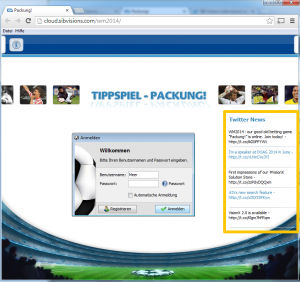
Twitter Storage implementation
The storage extends the standard AbstractMemStorage of JVx.
 |
|

Unser gutes altes Tippspiel ist für die WM 2014 bereit. Wir sind zwar etwas spät dran, aber noch ist alles möglich.
Wenn du einen unserer 3 Fan-Preise gewinnen möchtest, spiel einfach mit:
Der Link zur Info Seite: http://wm2014.sibvisions.com
Vergiss bitte nicht, auf die Topwette (der Weltmeister). Damit kannst du dir am Ende 20 extra Punkte krallen und ev. noch den Sieg an dich reißen. Die Topwette kann nur vor dem Turnierstart gesetzt werden.
Auch in diesem Jahr halten wir dich via Twitter, nach jedem Spieltag, auf dem Laufenden! |
We've released JVx 2.0.2 last friday and you should know that it's available 
It's a smaller update with bugfixes and some improvements. One new feature is the support for an additional row in the databook. We use this row for searching records.
Other interesting features, from the changelog, are
- added listener to IConnection for notifications about property changes
- DBAccess isModified introduced
- register value changed of single column
- register key event listener for certain key
- DataBookBuilder introduced
- ICloseable introduced
- Set ORDER BY as property of DBStorage
- new selection modes: CURRENT_ROW_DESELECTED, CURRENT_ROW_SETFILTER
CURRENT_ROW_DESELECTED_SETFILTER
- CommonUtil.close introduced
Have fun 
We didn't have support for Buttons with popup menus in JVx because standard Swing doesn't support this feature out-of-the box. But such a component would be very useful for some UIs.
We didn't change our UI definition but we started with support in Swing. Our JVxButton now has support for showing a popup menu. It could be like this one:

DropDown
We've added some buttons to VisionX, because it reduces the amount of buttons 
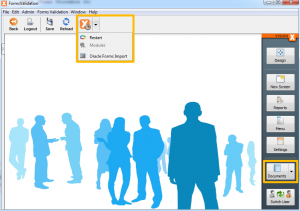
VisionX with new buttons
It's easy to use the new feature in your Swing application and also in your JVx application (for Swing UIs):
UIPopupMenu pmDocumentation = new UIPopupMenu();
pmDocumentation.setTranslation(getLauncher().getTranslation());
pmDocumentation.add(miHelp);
pmDocumentation.add(miSpecification);
((JVxButton)butDocumentation.getResource()).setPopupMenu((JPopupMenu)pmDocumentation.getResource());
//because we add the resource
pmDocumentation.addNotify();
There are some things to know:
- Set the translation because the resource is added and the UIPopupMenu doesn't have a parent.
- Call addNotify to enable translation (same problem because of missing parent)
- You should check if the resource of the button is an instance of JVxButton to be UI technology independent
If you work with above code, you'll have all JVx features like simple event handling or translation.
 |
|
I'm a speaker at DOAG 2014 in Dusseldorf. My talk will be about "Rapid development - Oracle Forms and Java united"
Check the schedule at 3:30 pm Schnell entwickeln! Vorteile von Forms und Java vereint.
I'll show you how you can develop ERP Applications with Java and embedd them into your existing Forms. You'll see how both worlds work together. Don't miss well known Features of Oracle Forms. I'll show you that Java has the same features and more. If you want to know more about fancy Forms - listen to my talk. |
With the next VisionX release we'll include the Solution Store. It's exactly what it sounds like and even better.
The Solution Store is a place for Applications, AddOns, Modules and other pluggable components for VisionX. The Store will be hosted in our infrastructure and it will be a Store in the cloud. But it will be possible to run your own store in your own infrastructure. The "cloud store" will be public and has special offers for users which owns a valid VisionX license. We'll use the store to share demo applications and other free stuff. It'll be easier for you to install our demo applications because you'll know where they will be.
The Solution Store is seamless integrated in VisionX and is super easy to use.
A first impression:
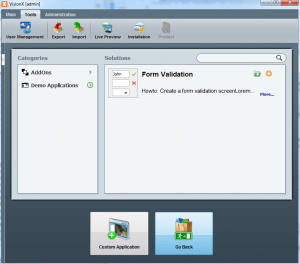
VisionX Solution Store
The store itself is a JVx application (backend and frontend) but it's not Open Source.
The big advantage is flexibility for you and your suppliers. Your suppliers will be able to add specific versions of an application without changing your VisionX installation. If you have different AddOns or test applications, simply add it to the store and don't loose anything. If you delete an application, no problem it's still in your own Store.
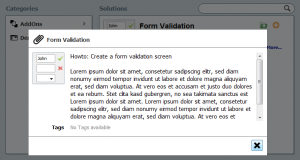
More...
The Store integration will be available with one of our next nightly builds for a small group of customers.
Since VisionX 2.0 we have a feature that checks "application healthieness". This feature is not important for end-users but could be important for developers. If a developer manually changes source code of an application, it's possible that the application has compile problems after next VisionX update. This could happen if an API was changed or a library was missing. If an application couldn't be updated or has other unexpected errors, you'll get following in VisionX
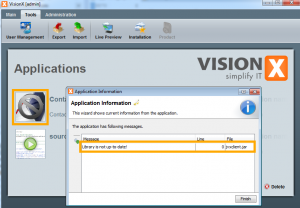
Application check
If you click on the black sign, you'll see all problems. You can export the list and after all problems were fixed, the application sign will be removed. It's not possible to start an application with such a sign because you could destroy parts or the whole application. It's a quality improvement for VisionX and you.
We've added a new feature to our model. It's an additional search row. The row is invisible per default, but you can show the row if you need/want it. With this additional row visible, your tables automatically will show a search row like this:
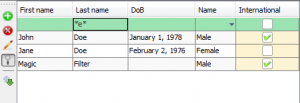
New search row
We use the search row with background color green, in our applications. The feature will be available with next nightly build and it's already available in our repository.
It will be possible to en-/disable the search row with VisionX via Customizer:
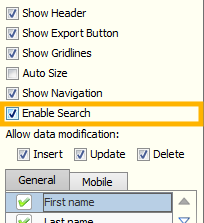
En-/Disable search
This new feature is a must-have for all Oracle Forms users because this is a replacement for Enter-Query Mode.
If you have a lot of work-screens in your application, it's not so easy to find the right screen because VisionX didn't offer search functionality in its open-screen wizard. With upcoming releases, VisionX will have such search functionality:
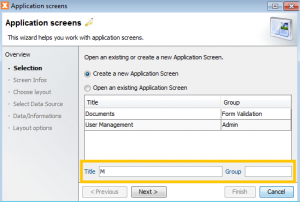
Screen search
The search fields will be visible if you have more than 5 screens!
Another problem with screens is that you can't search for fields or don't see automatically hidden fields, like ID columns. We have another nice search feature for you:
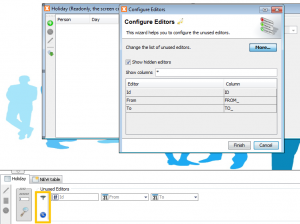
It will be possible to show hidden fields and also the used column name of your database table. The column names are not visible by default, but will be after you've pressed More... 
I'm very happy to announce that VisionX 2.0 is available. It's available as Trial version or Online via Cloud Login.
Use our registration form and request a trial license or request a Cloud Login.
If you have any questions, feel free to send us a message via Twitter (@sibvisions), leave a comment or send us an email.












 RSS-Feed
RSS-Feed